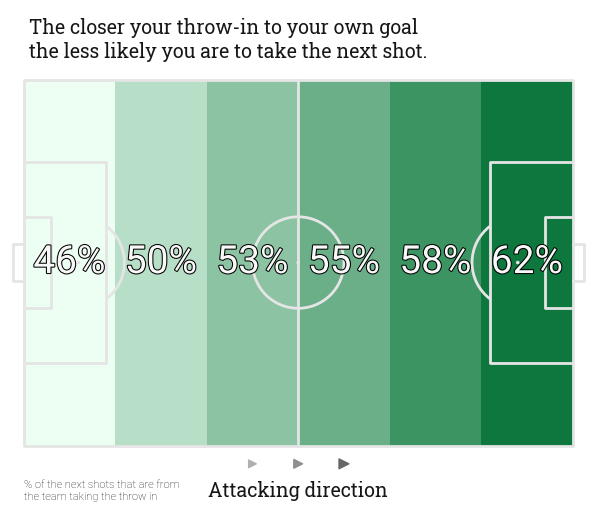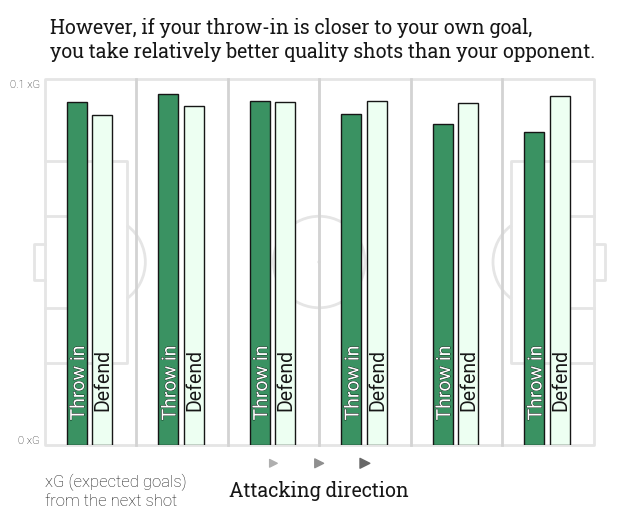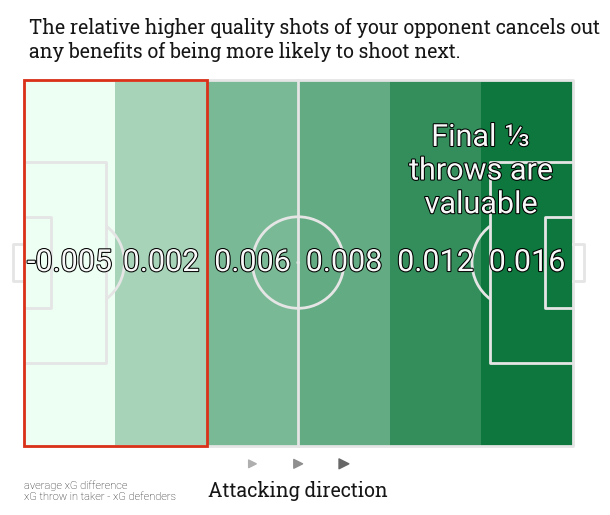
- This blog explores whether football (soccer) players should launch long balls into touch in the final third, conceding possession for a throw-in but gaining territorial advantage.
- On average, this strategy is neutral. Any advantage of being more likely to take the next shot as you’re closer to the opposition goal is offset by the risk of facing counter-attacks with higher quality shot opportunities compared to what your team would have generated.
- On the other hand, if your team wins an attacking throw in the final third, it results in a positive expected goals (xG) difference (+0.014 per throw-in).
Should Players Launch a Long Ball into Touch, Conceding a Throw-in?
Inspired by rugby tactics, I investigated whether football players should employ a strategy of launching long balls into touch. This approach concedes possession via an opponent’s throw-in but positions the ball closer to the opposition’s goal. For this analysis, I utilized the Hudl StatsBomb open-data set from the 2015/16 season, covering the men’s “Big-5” leagues (the top divisions in England, Italy, France, Spain, and Germany).
The Strategy is Neutral
Launching a long ball into touch is, on average, a neutral strategy.
- Launching the ball into the final third touch means your team is more likely to take the next shot than your opponent.
- However, if your opponent retains possession from their resulting throw-in, they tend to create higher quality shot opportunities compared to what your team would have generated.

- The higher shot quality of your opponent effectively negates any territorial gain from launching the ball. On average, this results in a neutral Expected Goals (xG) difference (approximately zero) from launching the ball into touch. Interestingly, an attacking throw-in in the final third does result in a positive xG difference (0.014 per throw-in).
In this analysis, I build on goal difference, and define xG difference as the sum of xG from the team taking the throw-in minus the sum of xG from the team defending the throw-in. A negative xG difference would suggest it’s advantageous to kick the ball into touch and defend the throw-in, as the team taking the throw-in would, on average, concede more goals than they score.

For this analysis, I matched data from approximately 79,000 throw-ins to the next shot in the game period (excluding about 6,000 throw-ins without a subsequent shot). It’s important to note that the data is ten years old, potentially missing recent advances in advances in set piece tactics and pressing strategies employed by teams.
Summary: A Neutral Strategy, but Attacking Throw-Ins Show Promise
While launching the ball into touch doesn’t appear to be a viable strategy on average, there may be exploitable positional lineups, pressing systems, or specific circumstances that could make this strategy effective and counter the risk of conceding higher-quality shots. However, even a decade ago, attacking throw-ins in the final third showed potential for gains. As Ted Knutson notes in the Transfer Flow podcast, throw-ins offer three distinct advantages over open play passes:
- you cannot be offside.
- you can plan mismatches and overloads.
- the player taking the throw in can see all the players on the pitch.